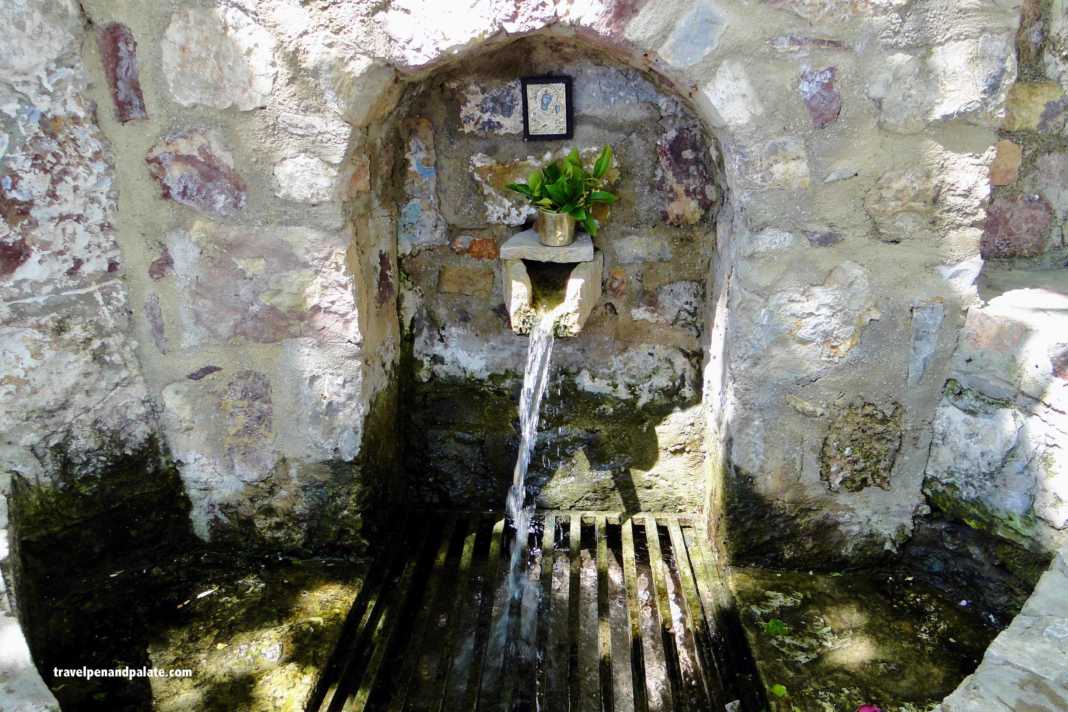“They do not need to go away. You give them something to eat.” What food did they have? A little boy had brought his lunch, consisting of five loaves and two fish… all were fed. And not just fed—stuffed.
Learning Lessons from the Loaves, Fr. Lawrence Farley
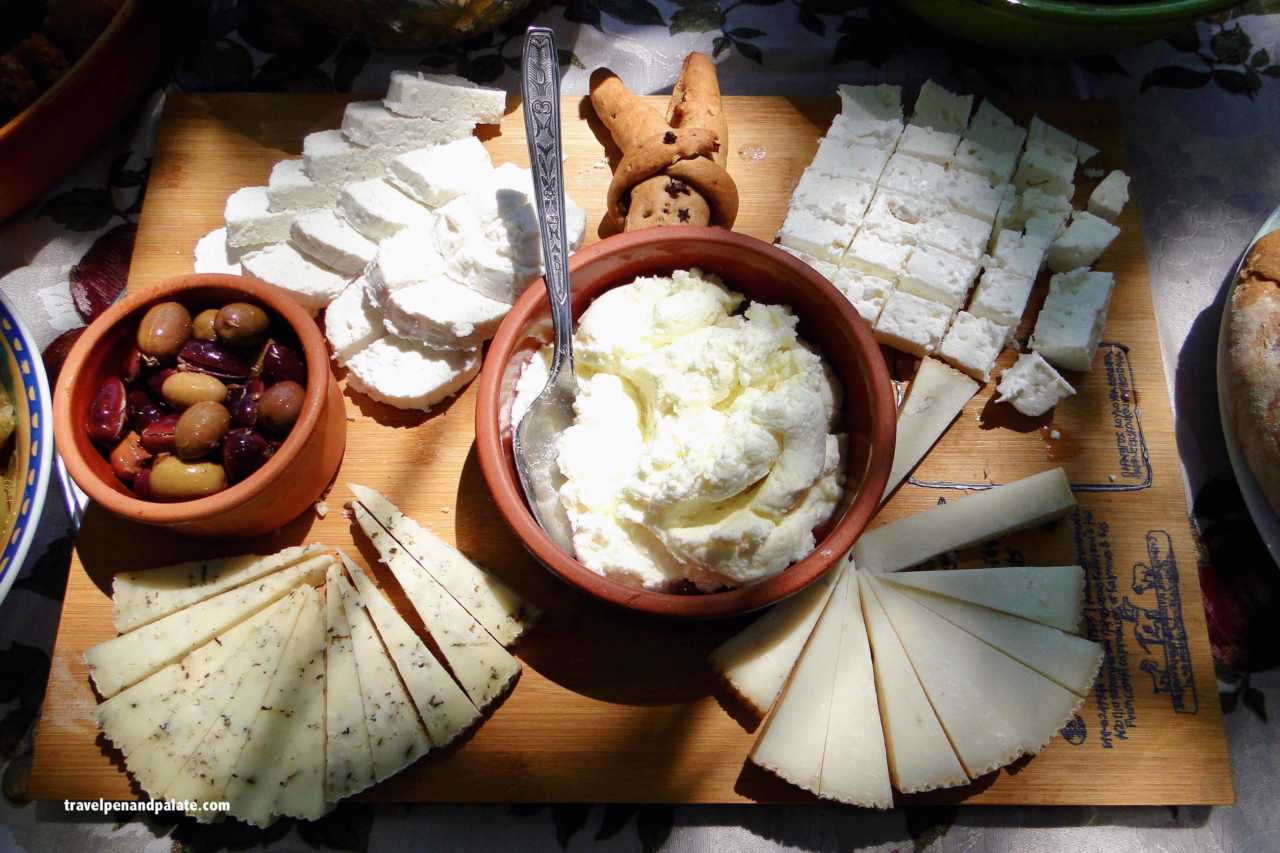
Parable or miracle, the multiplication of loaves and fishes has xenia at its roots – the ancient Greek concept of hospitality without self-aggrandizement. Sharing within a community was not charity; it was survival, support and entertainment. Kalymnos Island’s life style reflects xenia.

Skalia’s villagers must have emptied their vegetable bins. The dinning hall was the cliff side town plaza, shaded by massive trees with panoramic views of neighboring Telendos and Calabros islands. The long tables groaned under the more than 15 dishes to be shared with a couple dozen new friends.
During the fasting periods of Greek Orthodox Lent, meatless feasts are created in many homes and villages. St. Lazarus Day is the Saturday preceding Palm Sunday’s opening of Holy Week when even dairy and fish are forbidden. The cupboards are emptied of excess foods. This particular gathering was in honor both of St. Lazarus and myself – yes, I was as surprised as you.
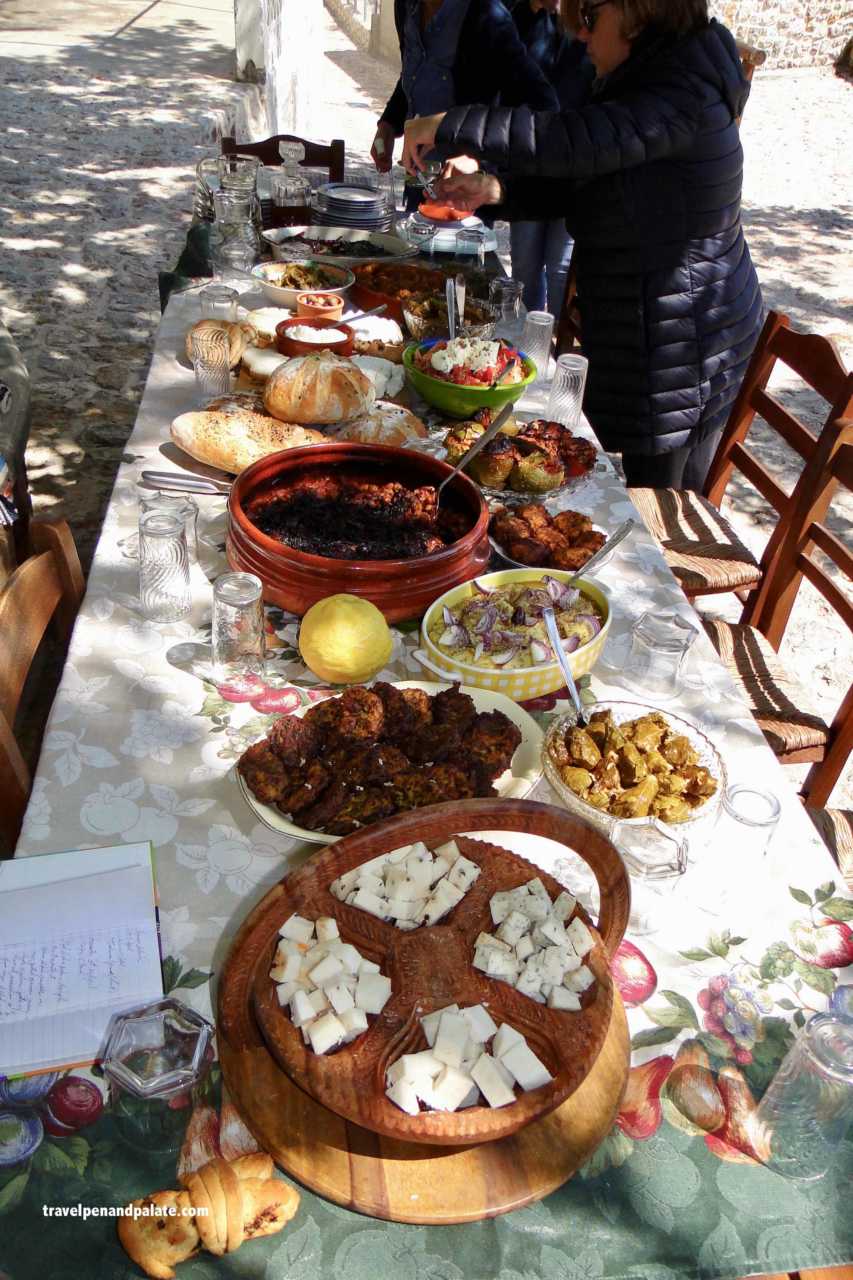
The village of Skalia (aka Skala, aka Ωρωπός) has been settled since the early Hellenistic period. c. 2,500 BC. The ancient first residents named Skalia after themselves. A classic small Greek island village, it hugs the rocky coast and its hillside perch.
Pure, ice-cold water, like an eternal flame, pours from a mountain spring into a small pool at the base of an ancient tree. It’s still gathered for drinking, as it has been for eons. Home made wine flowed smoothly as well.
There are traditions that are expectations. On Kalymnos cooking and music are a given. The dishes at Skalia’s St. Lazarus Day lunch were redolent of fresh vegetables, herbs and seasonings all having names among Greek classics yet prepared with, a given as well, the personal creativity of the cook (and a thank you to the family ancestors).
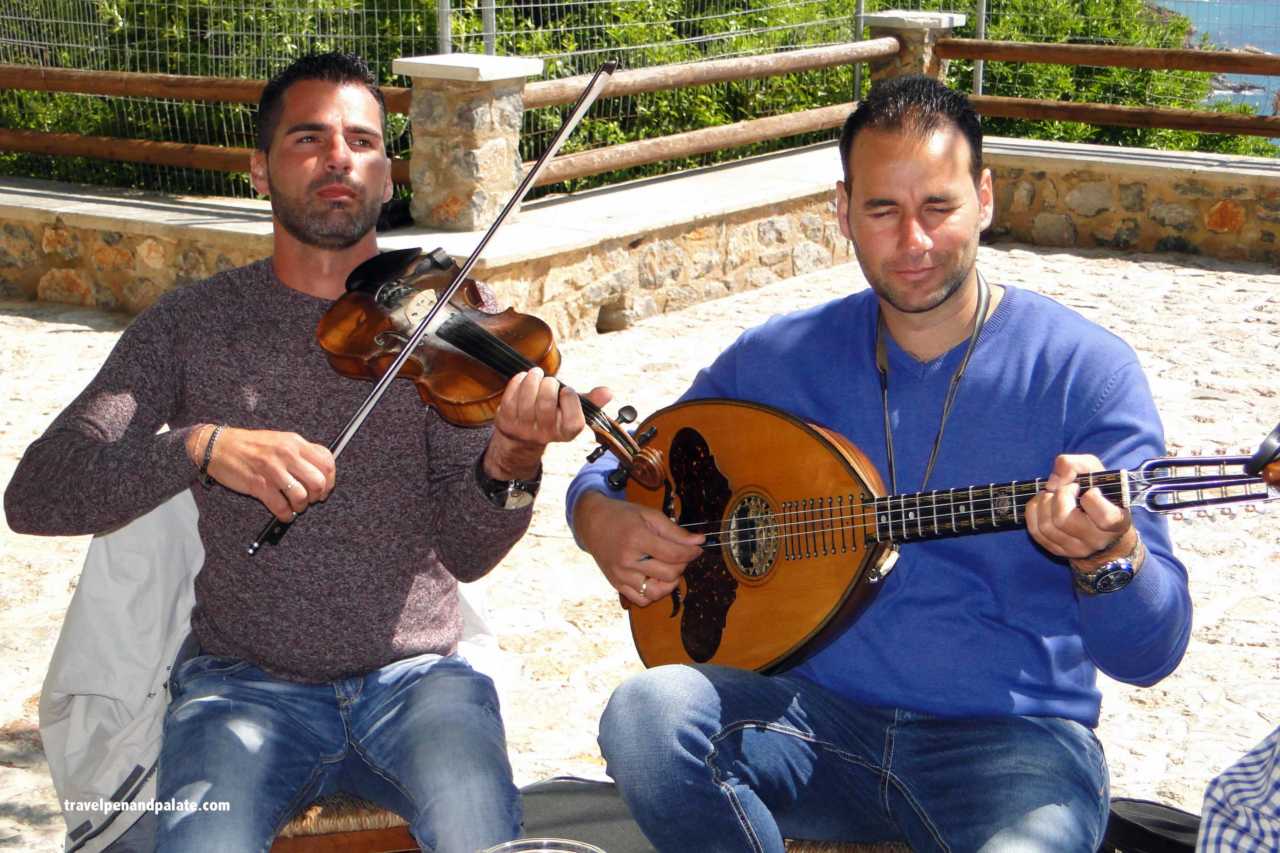
Brothers Nikitas and Theofilis Kalidonis epitomize the music tradition. Before pre-school age these brothers were introduced to the classic instruments and music of Kalymnos and Greece. They work for the family contracting business, but music was a tradition of equal importance.
As the Brothers Kalidonis performed after lunch the sound was fresh and new in their talented hands. Villagers danced and the crisp spring day sunlight gleamed. No wonder St. Lazarus had a subtle smile, as he rested, on his day, contented as bread.
Such a display of hospitality to a stranger passing through is embedded in the pre-Christian psyche – xenia. Zeus himself was protector of travelers and was sometimes referred to as Zeus Xenios. The reality that traditions mesh overtime becomes the matrix of culture: the divine, home, work.
Divine

The Church of Agios Mamas (c. 5th century) in Skalia was built on ground sacred to the ancients. Like so many of the earliest Christian churches they incorporated architectural artifacts from the old temple that preceded them. Of interest on this St. Lazarus Day – considering the miracle took place in his tomb – was that the church was built over catacombs.
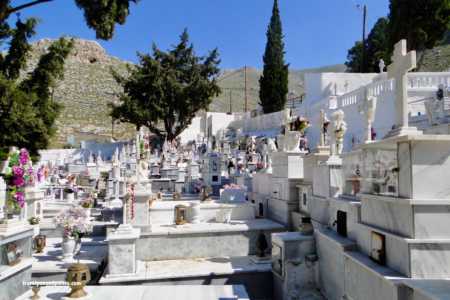
The intimate interior is brilliant with frescoes and icons glinting in the candlelight. Agios Mamas was filled with worshipers filing to the communion chalice. At coffee hour small blessed Lazarus breads were distributed along with strong Greek coffee, ice water and koulourakia, a spiral, spiced Easter cookie that’s traditionally dipped in coffee.
Perched on a hillside and befitting it’s ancient catacomb roots, Agios Mamas gleams in the sunlight reflecting off of hundreds of white marble tombs. It’s a garden of marble.
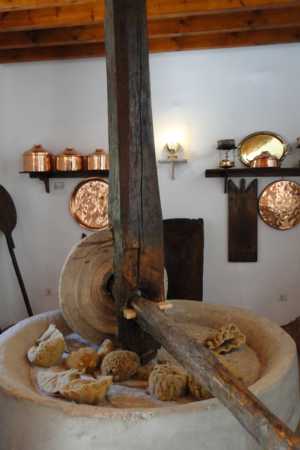
The current Monastery Panagia (dedicated to the Virgin Mary) in Arginonda was constructed mostly in the mid-1800s and replaced an earlier Byzantine church (St. Nicholas). It’s built next to a 1780 olive press, the oldest on the island (now an olive museum). It was the first olive press on Kalymnos and only the second in the Dodecanese (olives were a gift from Athena).
At one time a sheepherder found an icon of the Virgin Mary in a nearby cave (there are a lot of caves on Kalymnos). Taking it to local villages the icon was credited with saving lives during an outbreak of the plague. Yet each time the icon was removed from the cave it would return overnight.
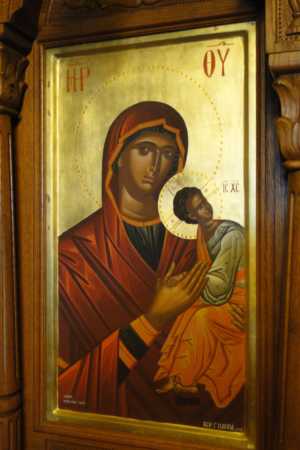
The icon wanted a proper home. When the church was built it was most happy to take up residence. On this Palm Sunday her church was brightly festooned with the traditional decorations of the Orthodox Church.
At the Palm Sunday coffee a breakfast of fried fresh sardines, olives, bread and the sweet wine of Kalymnos were passed at long tables. Even though it’s the start of Holy Week, fish is allowed on Palm Sunday – a good time to empty the kitchen. Bowls of bright red Easter eggs are reminiscent of the celebratory red eggs used in Oriental cultures at weddings, births, New Year’s and momentous events. In the Orthodox Church they represent the blood of Christ.
If the bells of Saint Nicholas spontaneously ring then the perpetual light to the icon, beeswax candles, burnt down before someone lit another. Although this is a rare occurrence I was told they did ring recently, and the candles were out.
Home
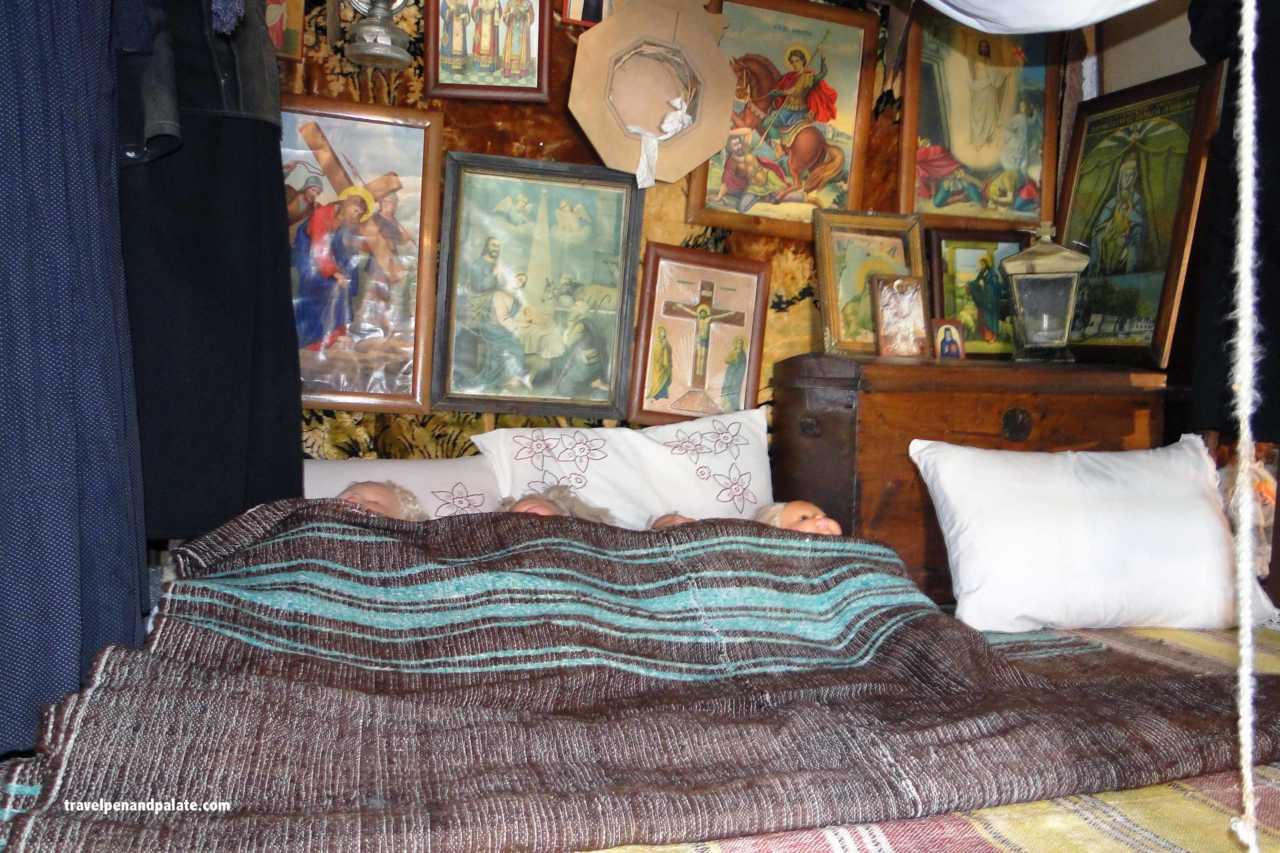
The Traditional House of Kalymnos (aka Kalmniko Spiti) a privately held folk museum, founded by Mrs. Scylla – Chalkidiou is a microcosm of Kalymnos popular culture. Even the house itself is a story in community evolution. It’s at the very core, the family.
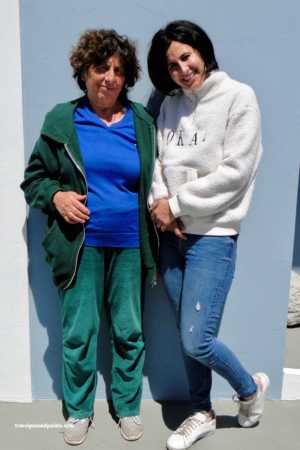
The museum is a restored one-floor 19th century farmhouse that has been, naturally, in the family. But a second 21st century floor lays recessed on top. It is a modern evolution of marriage and dowry.
Tradition holds that the family provides a house for a daughter as her dowry when married. Mrs. Scylla – Chalkidiou’s daughter had no immediate plans for marriage but a great interest in the museum and the old house. Adding a modern second floor apartment recessed from the top front so as not to alter the historic facade was the solution.
What first seems cluttered are artfully arranged displays. The visual impact becomes a kaleidoscope of life from mourning rituals to lost sponge diver husbands and sons, porcelain from the China trade to the latest in undergarments. The bedroom reminds that the idea of a close family was for real when there was only one bed to share.
There was a practical reason for one bed. Herb wood was used for cooking fire, but in this firewood sparse island there was no heating fire for the house. The entire family slept in one bed, sometimes in shifts.
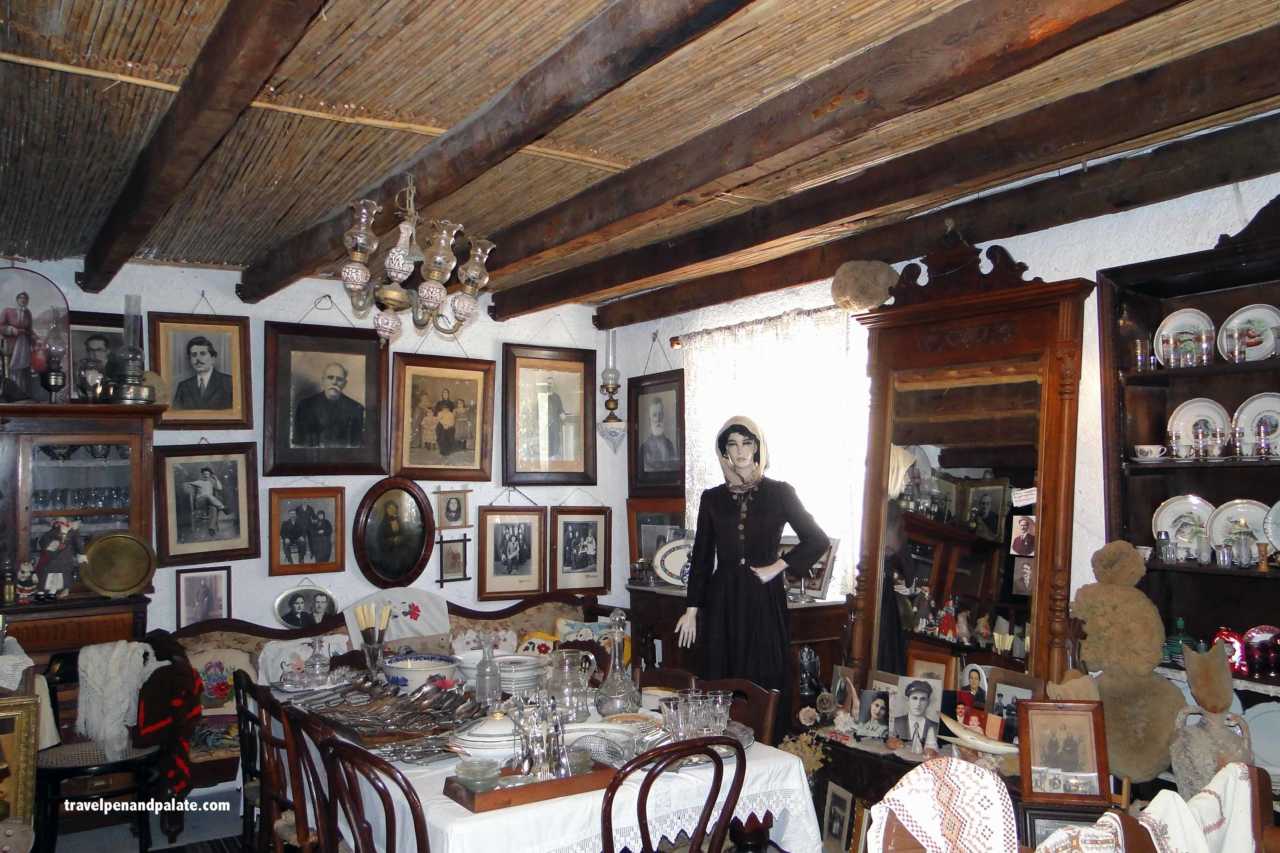
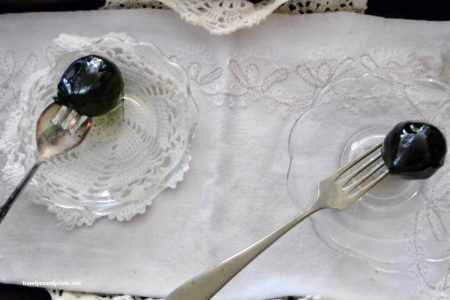
What looks to the visitor as a sparse land is actually rich and lush with culinary plants especially herbs. Mrs. Scylla – Chalkidiou collects herbal and fruit recipes from surrounding families to keep culinary and medicinal traditions alive. Besides her cook book the gift store of the museum offers a variety of herbal products, preserved organic foods and skin care lotions. These are of great interest to the hikers, rock climbers, divers and other sports tourists who flock to Kalymnos. The fig spoon sweet was savory with syrup not too thick making the fruit fresh and natural.
Work
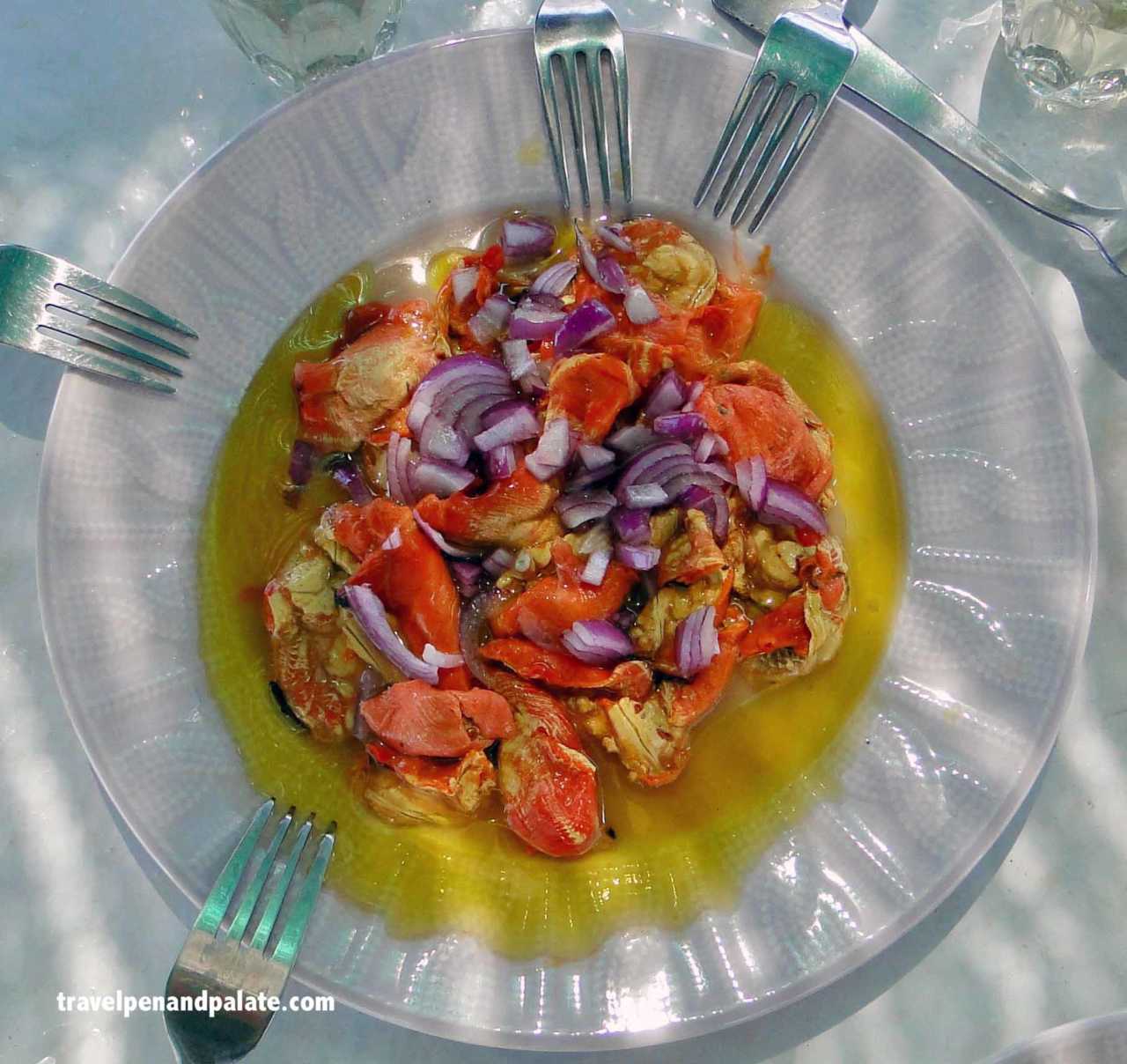
Spinialo (fouskes) has a beautiful orange yellow color. It’s usually preserved in olive oil and salt shortly after bringing on board. It’s a favorite food among sponge divers for two good reasons. Divers picked these delicacies while raking sponges and if preserved could be taken on their long trips out to sea.
Sponge diving was the economic engine of Kalymnos Island for centuries. It was an international trade for this sought after commodity. Diving ships spent half a year in the Aegean and half off the North African coast (fewer taxes in countries such as Egypt).
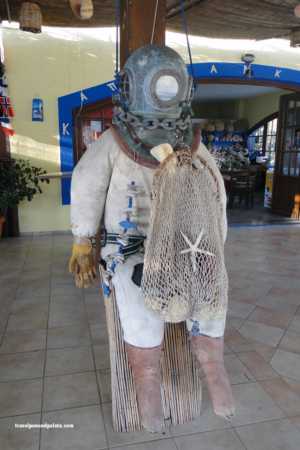
The modern diving suit was invented on Kalymnos in the mid 19th century and revolutionized the industry. It solved two major problems. Most work was done in shallow water (snorkeling depth) where sponges could be raked. Deep water diving could be profitable because of the abundance of sponges but deadly.
The bends was often a death sentence caused by complications with the body’s ability to handle pressurization. The diving suit and then the oxygen tank greatly reduced the possibility of death. Kalymnos led the way in diving innovation.
Despite Red Tide, which struck in the 1980s all but putting an end to the sponge industry for 25 years, Kalymnos’ commercial fishing fleet remained strong. Kalymnos has the second largest fishing fleet in the Mediterranean – 400 commercial ships. One-third of the 12,000 permanent population on the island are involved in fishing. The Maritime Training Center is one of Europe’s most respected and internationally certified.
The same fate fell to Tarpon Springs in Florida in the 1980s. In the late 1890s hundreds of sponge divers from Kalymnos and other Dodecanese islands were recruited to settle this new town. Today Tarpon Springs, on the Gulf Coast, is one of America’s largest Greek towns and strives to preserve its heritage. Tarpon Springs’ economy transitioned as the Florida Gulf Coast grew, but sponges are back as Red Tide also abatted.
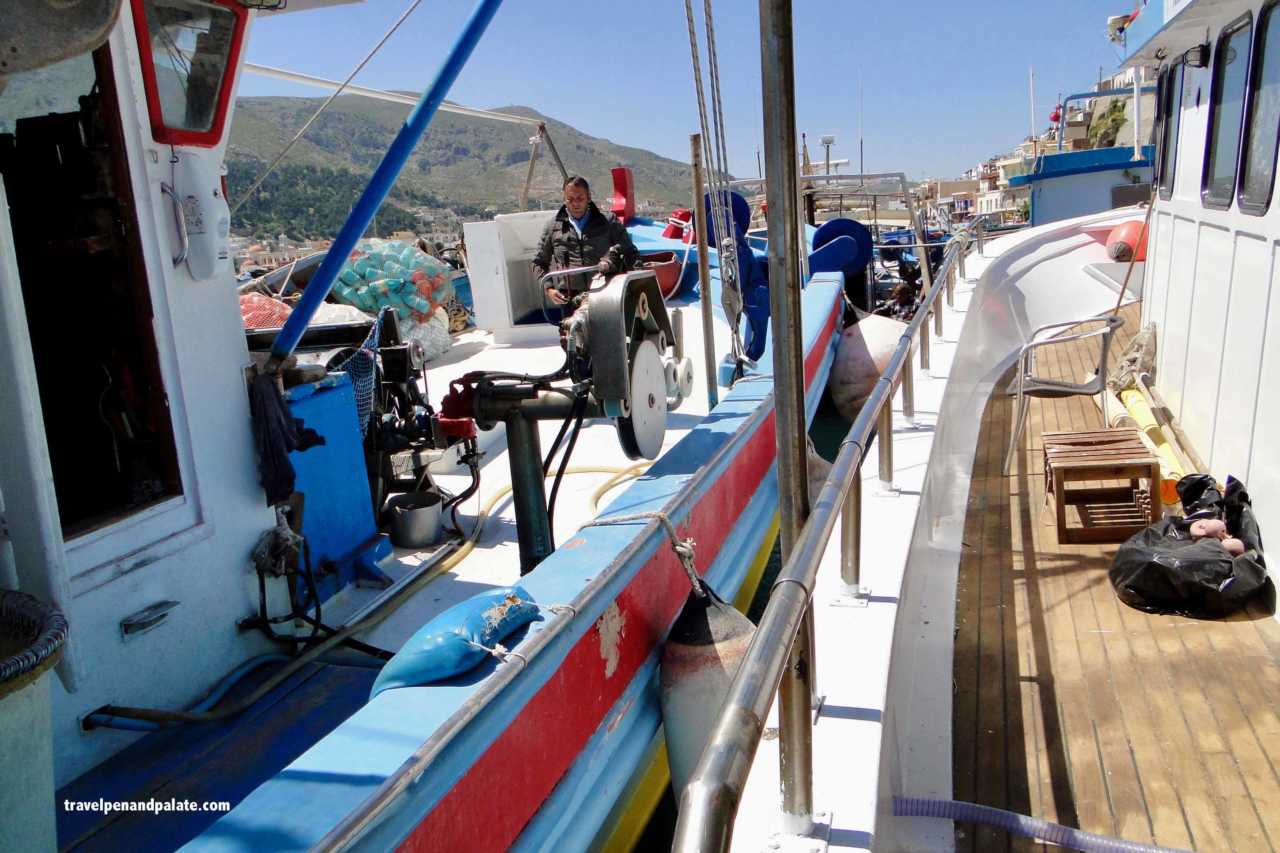
Fortunately the large commercial fishing fleet on Kalymnos Island was able increase supply of the Aegean’s abundant fish and the sponges have come back. While diving for sponges they collect urchins, mussels, lobsters and fouskes because they live at the same depth.

Kalymnos Sponges’ Warehouse currently processes 80% of their sponges for gift shops for the summer tourist season. The demand is greater than supply. I did not know that a loofah sponge is a land-growing plant. Sponges are separated industrial to cosmetic grade and must go through a specific cleaning process.
Yet too many wars and crisis etch scars on this cultural matrix. At the Monastery of Saint Savvas bomb casings dredged up by the sponge divers become art. Like the loaves and fishes their bronze magnificence multiplies into such objects as bells. Their deep tone resonates a reminder: xania is a conscious decision; it’s not magic.
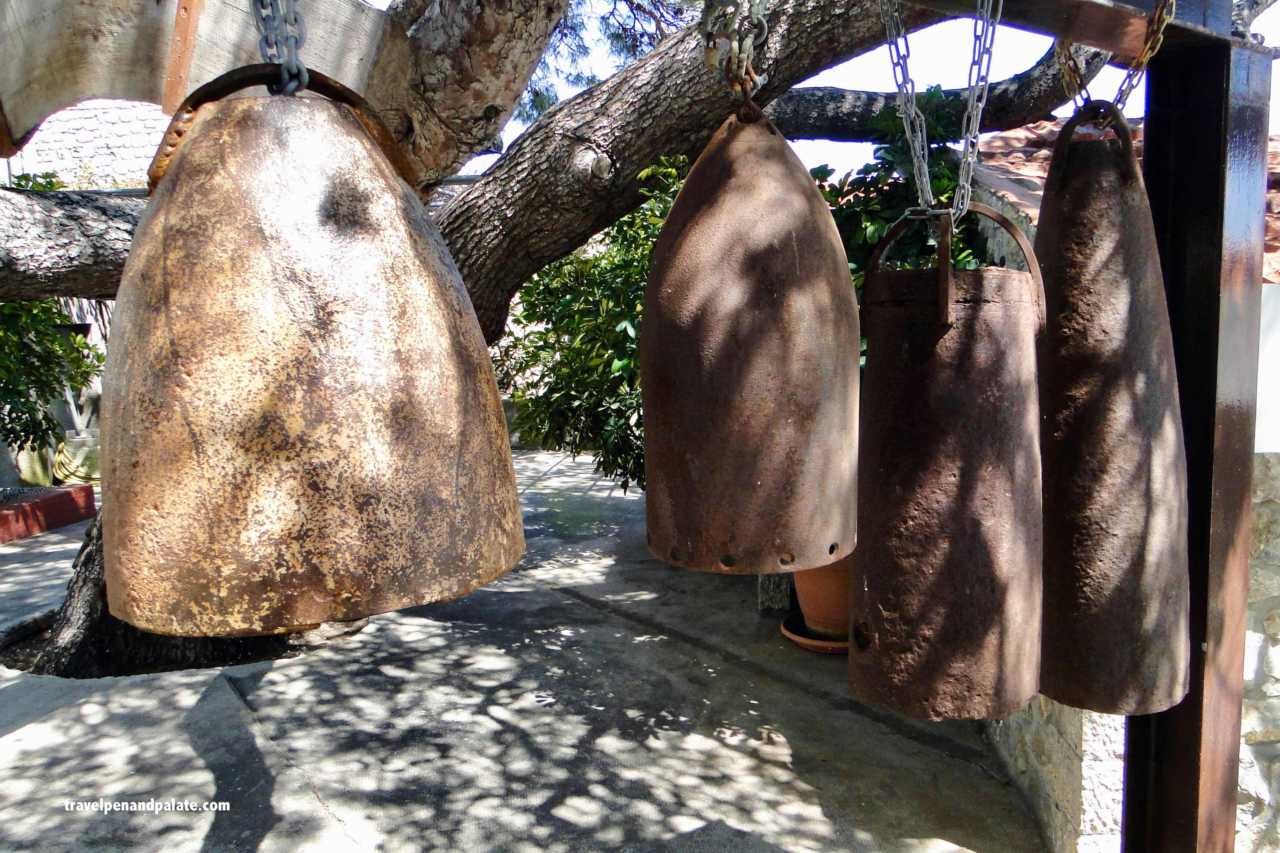
When you go: Kalymnos is served by both air and ferry service from Athens. Schedules are seasonal so do check. It is usually possible to reach the Island year round through Kos Island by air and/or ferry.
Where to stay and dine: additional articles will be out shortly
- Myrties Boutique Apartments
- Carian Hotel
- Oasis Hotel
- Poppy’s Grill Taverna
- Azul Restaurant
- Anna’s Restaurant
Things to do: on Kalymnos Island
- rock climbing
- hiking
- diving
- and….
On Facebook: I Love Kalymnos !!!!!!!!!!!
Special Thanks: for facilitating my tour Kalymnos Association of Tourist Accommodation “Xenias,” Maria A. Sarafoglou, Fotini Tiliakou, Kalliopi Tsangari, Maria Helle Foy,Nikolaos Pelekanos, and Giannis Karamalis
Travel with Pen and Palate every month to Greece and the world in the Hellenic News of America.
(1) Learning Lessons from the Loaves, Fr. Lawrence Farley, Orthodox Church in America, July 27, 2015 https://www.oca.org/reflections/fr.-lawrence-farley/learning-lessons-from-the-loaves


